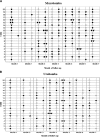Diarrheagenic Escherichia coli: Prevalence and Pathotype Distribution in Children from Peruvian Rural Communities
- PMID: 27382080
- PMCID: PMC5014262
- DOI: 10.4269/ajtmh.16-0220
Diarrheagenic Escherichia coli: Prevalence and Pathotype Distribution in Children from Peruvian Rural Communities
Abstract
Diarrheagenic Escherichia coli (DEC) are common pathogens of childhood gastrointestinal infections worldwide. To date, research tracking DEC has mainly been completed in urban areas. This study aims to determine the prevalence and pathotype distribution of DEC strains in children from rural Peruvian communities and to establish their association with malnutrition. In this prospective cohort, 93 children aged 6-13 months from rural communities of Urubamba (Andes) and Moyobamba (jungle) were followed for 6 months. Diarrheal and control stool samples were analyzed using multiplex real-time polymerase chain reaction to identify the presence of virulence genes of DEC strains. The overall isolation rate of DEC was 43.0% (352/820). Enteroaggregative E. coli (EAEC, 20.4%), enteropathogenic E. coli (EPEC, 14.2%), and diffusely aggregative E. coli (DAEC, 11.0%) were the most prevalent pathotypes. EAEC was more frequently found in Moyobamba samples (P < 0.01). EPEC was the only strain significantly more frequent in diarrheal than asymptomatic control samples (P < 0.01). DEC strains were more prevalent among younger children (aged 6-12 months, P < 0.05). A decline in height-for-age Z-score (HAZ) was observed in 75.7% of children overall. EAEC was more frequently isolated among children who had a greater HAZ decline (P < 0.05). In conclusion, DEC strains were frequently found in stool samples from children in rural communities of the highlands and jungle of Peru. In addition, children with a greater decline in their growth rate had higher EAEC isolation rates, highlighting the importance of this pathogen in child malnutrition.
© The American Society of Tropical Medicine and Hygiene.
Figures



References
-
- O'Ryan M, Prado V, Pickering LK. A millennium update on pediatric diarrheal illness in the developing world. Semin Pediatr Infect Dis. 2005;16:125–136. - PubMed
-
- Kotloff KL, Nataro JP, Blackwelder WC, Nasrin D, Farag TH, Panchalingam S, Wu Y, Sow SO, Sur D, Breiman RF, Faruque AS, Zaidi AK, Saha D, Alonso PL, Tamboura B, Sanogo D, Onwuchekwa U, Manna B, Ramamurthy T, Kanungo S, Ochieng JB, Omore R, Oundo JO, Hossain A, Das SK, Ahmed S, Qureshi S, Quadri F, Adegbola RA, Antonio M, Hossain MJ, Akinsola A, Mandomando I, Nhampossa T, Acácio S, Biswas K, O'Reilly CE, Mintz ED, Berkeley LY, Muhsen K, Sommerfelt H, Robins-Browne RM, Levine MM. Burden and aetiology of diarrhoeal disease in infants and young children in developing countries (the Global Enteric Multicentre Study, GEMS): a prospective, case-control study. Lancet. 2013;382:209–222. - PubMed
-
- Lanata CF, Mendoza W. Improving Diarrhoea Estimates. 2002. http://www.who.int/child_adolescent_health/documents/pdfs/improving_diar... Available at. Accessed February 24, 2016.
Publication types
MeSH terms
LinkOut - more resources
Full Text Sources
Other Literature Sources
Medical
Research Materials

